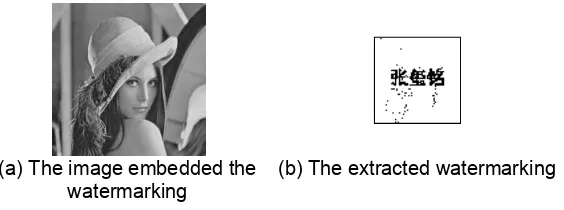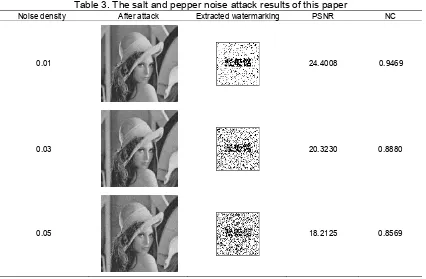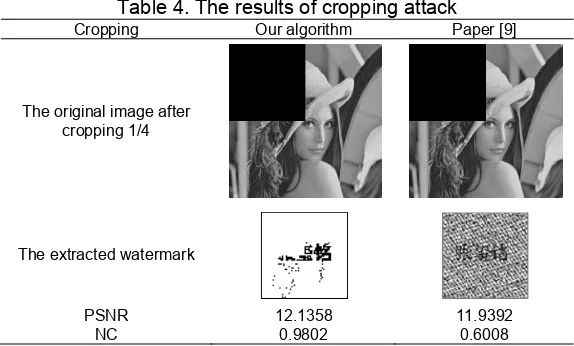DOI: 10.12928/TELKOMNIKA.v14i4.4064 1424
Digital Image Watermarking Algorithm Using the
Intermediate Frequency
Hong-an Li*1, Zhanli Li2, Zhuoming Du3, Qi Wang4 1,2
School of Mechanical Engineering, Xi'an University of Science and Technology, Xi'an, China
1,2
College of Computer Science and Technology, Xi'an University of Science and Technology, Xi'an, China
3
School of Computer Engineering, Jiangsu University of Technology, ChangZhou, China
4
School of Information Science and Technology, Northwest University, Xi'an, China *Corresponden author, email: [email protected]
Abstract
Digital image watermarking is one of the proposed solutions for copyright protection of multimedia data. This technique is better than Digital Signatures and other methods because it does not increase overhead. Watermarking adds the additional requirement of robustness. To improve the robustness of digital image watermarking method based on the image frequency, this paper adopts the intermediate frequency to embed the watermarking and proposes an digital image watermarking algorithm based on robust principal component analysis (RPCA) and discrete cosine transform (DCT). Firstly, the high frequency part and the low frequency part of the image are extracted by the RPCA algorithm. Because the high frequency part has complex statistical characteristics, this paper processes the high frequency part with "8×8" DCT method to obtain intermediate frequency coefficients and then the watermarking information is embedded into the obtained intermediate frequency coefficients. The experimental results show that the proposed algorithm leads to satisfactory robustness to the attacks of impulse noise and cropping.
Keywords: digital watermarking, robust principal component analysis, discrete cosine transform,
intermediate frequency part
Copyright © 2016 Universitas Ahmad Dahlan. All rights reserved.
1. Introduction
Digital image watermarking is a process of embedding a piece of digital content (image) into the original image and also it protects digital content from illegal manipulations. The hidden watermark should be inseparable from the host image and robust enough to resist any manipulations while preserving the image quality [1]. Watermarking adds the additional requirement of robustness. An ideal watermarking system would embed an amount of information that could not be removed or altered without making the cover object entirely unusable [2]. So, watermarking is mainly to prevent illegal copy or claims the ownership of digital media. It is a measure of immunity of watermark against attempts to image modification and manipulation like compression, filtering, rotation, collision attacks, resizing, cropping, etc [3]. In order to minimize the damage of the original image and enhance the robustness, a kind of algorithm has been proposed based on the image being layered. At present, the wavelet decomposition method is the most familiar method based on this kind of algorithm [4-6].
2. Robust Principal Component Analysis
The RPCA method decomposes an image into a low rank matrix image and a sparse matrix image [10-12]. If a matrix could be decomposed into a linear combination of a low rank matrix and a sparse matrix, as the equation M = A + E shows, then the two matrixes could be obtained by using some math method [13]. Where, A is a low rank matrix and E is a sparse matrix. The low rank matrix A could be recovered from the corrupted matrix M = A + E, as shown in Figure 1 [14]. The RPCA method can overcome the shortcoming of correlation data loss when the traditional PCA method is used to reduce the high-dimension.
(a) Data_matrix M (b) Low_rank_matrix A (c) Sparse matrix E Figure 1. Components Decomposition by RPCA
In the RPCA algorithm, the size of item is arbitrary, but the support set is sparse and unknown. Assuming that a given data matrix D∈Rm×n is a low rank or approximate low rank matrix, the optimal matrix A could be obtained by the traditional PCA when the elements of the separated sparse matrix E could be described by an independent identically distributed Gaussian distribution that is to solve the following optimization problem [14]:
, ‖ ‖
. . (1)
The matrix is solved with the singular value decomposition method (SVD), then the optimal solution of the above optimization problem would be obtained. If is a sparse noise matrix, the traditional PCA is not applicable. Then, to recover the low rank matrix becomes a double objective optimization problem:
min , , ‖ ‖
. . (2)
And then the compromise factor λ is introduced, the double objective optimization problem is transformed into a single objective optimization problem:
min , λ‖ ‖
. . (3)
This problem is an NP problem, so the objective function of the optimization problem needs to be relaxed. Due to the nuclear norm of the matrix is an envelope of the matrix rank, the norm is equal to 1,1 -norm under certain conditions. So the problem is relaxed to the following convex optimization problem:
min , ‖ ‖∗ λ‖ ‖
. . (4)
In the actual calculation, the paper [12] suggests λ ⁄ , . The above optimization problem is also called RPCA.
At first, the augmented Lagrange function is constructed:
L , , , ‖ ‖∗ λ‖ ‖ , ‖ ‖ ⁄ (5)
When Y Y , , the alternating method is adopted to solve the optimization problem min , , , Y , . The matrix and are iterated alternately using the exact ALM (EALM)
algorithm. If , then:
min , , ,
min ‖A‖∗ ⁄ (6)
Update the matrix according to the obtained :
min , , ,
min ‖E‖ ⁄ (7)
Denote and respectively to converge to ∗ and ∗ , then the update expression of the matrix is:
∗ ∗ (8)
At last update the parameter :
, ‖ ∗ ∗‖ ‖ ‖⁄
, otherwise (9)
Where, is a constant and is a small positive number.
The RPCA optimization method is a special case in many common optimization methods. According to this idea, this paper applies the RPCA algorithm into the digital image processing field and in the meantime a digital watermarking algorithm based on RPCA is proposed. This algorithm not only achieves the high visual quality but also the strong robustness to efficiently resist the attacks of impulse noise and cropping.
3. Discrete Cosine Transform
Discrete Cosine Transform (DCT) has advantages of high compression ratio, the lower bit error rate, the information concentration and small amount of calculation [16]. At the same time, the digital watermarking based on DCT domain is very familiar. The basic idea is to choose the low frequency coefficients to embed the watermarking into the image [17]. The low frequency part of image has more energy than other parts, so the watermarking embedded in the low frequency part could obtain higher robustness. The low frequency part is the smooth region of an original image, so the modification of this part will lead to reduce the quality of the image. The high frequency part is the texture of an image and the visual effect is good if the watermarking was embedded in this part, but it is sensitive to filter and compression. So, we adopt the intermediate frequency coefficients to embed the watermarking. Two-dimensional DCT [18] can be defined as Equation (10):
, ∑ ∑ , (10)
, ∑ ∑ , (11)
Where, can be defined as Equation (12):
, ,
, , , , ⋯ ,
(12)
The idea of image processing method based on DCT transform is that: Take the carrier image , as a two-dimensional matrix and use DCT transform directly to process the matrix and embed the watermarking into the carrier image [19]. This paper processes the texture layer with 8 8 DCT method, and then the watermarking is embedded into the obtained intermediate frequency coefficients.
4. Watermarking Embed and Extract Algorithm 4.1. Watermarking Embed Algorithm
Embed a watermarking image into a carrier image with following steps:
Step 1. At first, use the RPCA algorithm to extract the high frequency part and the low frequency part from the original carrier image ;
Step 2. Then, we apply 8 DCT transfor to the high frequency part , and then use keys to generated pseudo random sequences and , which are in order to record the watermarking pixel value (1 or 0);
Step 3. Denote the matrix as , , which is the original carrier image after the DCT transform. The intermediate frequency coefficients of this block are named as , 8 ,
, , ⋯ , , then we have formulas as following:
, , σ ,
, , σ , (13)
Where, σ represents embedding strength;
Step 4. Combine the high frequency part with the low frequency part and the process of embedding is complete. The image carrying the watermarking is named as ′.
4.2. Watermarking Extract Algorithm
Extract the watermarking from ′. The extraction process is outlined as following: Step 1. Apply DCT to the image ′ which carries the watermarking;
Step 2. Denote the matrix as ′ , , which is after the DCT transform of the image. The intermediate frequency coefficients are ′ , 8 , , ⋯ , . Then, calculate the value of each pixel according to the following formula:
W , , (14)
Where,
, , , (15)
Step 3. Complete the watermarking extraction and the watermarking is obtained. 5. Experimental Results and Analysis
(a) The original carrier image (b) The watermarking image
Figure 2. Original carrier image and watermarking image
After the watermarking image is embeded into the original carrier image, it is hard to distinguish Figure 2(a) from Figure 3(a) visually. Figure 3 shows the embedded carrier image and the extracted watermarking image using our algorithm.
(a) The image embedded the watermarking
(b) The extracted watermarking
Figure 3. The embedded carrier image and the extracted watermarking image
Use the robustness and invisibility indexes to evaluate the watermarking technology. As we can see from the Figure 2(a) and the Figure 3(a), they are very similar to each other. This shows that the algorithm invisibility is very strong. This is a subjective evaluation to the algorithm. Except the subjective evaluation, the objective evaluation is more important, such as Pak Signal to Noise Ratio (PSNR) and Normalized Coefficient (NC) [21]. The compared results of extracting watermarking image between our algorithm and the paper [9] whose method is based on wavelet transform are shown in Table 1.
As we can see from Table 1, the PSNR value of our algorithm is 31.4890 and the NC value is 0.9970 while the PSNR value of the paper [9] is 30.6912 and the NC value is 0.7615. So, in this aspect our algorithm is better than the paper [9].
Table 1. Comparing results of PSNR and NC Algorithm PSNR NC Our algorithm 31.4890 0.9970
Paper [4] 30.6912 0.7615
Table 2. Comparing results of the extracted watermark The original watermarking image Our algorithm Paper [4]
5.1. Salt and Pepper Noise Attack
The salt and Pepper noise attack is that black and white noises are added into the image to make the image fuzzy. Whether it could resist the salt and pepper noise attack or not that is a very important indicator to measure the performance of an algorithm. After the salt and pepper attack (the noise densities respectively are 0.01, 0.03, 0.05), the extract results are shown in Table 3.
Table 3. The salt and pepper noise attack results of this paper
Noise density After attack Extracted watermarking PSNR NC
0.01 24.4008 0.9469
0.03 20.3230 0.8880
0.05 18.2125 0.8569
From Table 3 we can see that the salt and pepper noise densities respectively are 0.01, 0.03, 0.05. The algorithm of our paper could extract the watermark, while the salt and pepper noise density is bigger than 0.01 the algorithm of paper [9] couldn’t extract the watermarking image. Therefore, these show that our algorithm has better ability to resist the salt and pepper noise attack than the paper [9].
5.2. Cropping Attack
Table 4. The results of cropping attack Cropping Our algorithm Paper [9]
The original image after cropping 1/4
The extracted watermark
PSNR 12.1358 11.9392
NC 0.9802 0.6008
From Table 4, when the cropping ratio is 1/4, the PSNR value of our algorithm is 12.1358, while the paper [9] is 11.9392. Moreover, the visual effect of our algorithm is better than the paper [9]. The NC value of the extracted watermarking image and the original watermarking image could reach to 0.9802, while the paper [9] is only 0.6008. So, our algorithm has better robustness to resist the cropping attack than the paper [9].
The RPCA algorithm could mostly avoid the effect that caused by a few of degenerate points and could converge to the right results. In the meantime, it would keep high calculation accuracy and avoid the data loss in the process of dimensionality reduction. So, our algorithm has higher performance than the paper [9] which is based on wavelet transform.
6. Conclusion
This paper extracts the low frequency part and the sparse part of the original carrier image using the RPCA method. And then the sparse part is handled with 8×8 DCT method to get the intermediate freqency coefficients and the watermarking image is embedded into the obtained intermediate frequency coefficients of sparse part . The experimental results show that the algorithm of this paper not only could obtain high visual quality but also could efficiently resist the attacks of cropping and the salt and pepper noise.
In the future, we will do our best to find more efficient ways to improve the ability to resist attacks such as geometric distortion, stronger noise and so on [23, 24].
Acknowledgements
This work is partially supported by the National Natural Science Foundation of China (Grant No. 61402206, 61472166, U216114), Scientific Research Program Funded by Shaanxi Provincial Education Department (Program No.16JK1497) and the Xi'an University of Science and Technology Cultivation Foundation Project (2014032). We declare that there is no conflict of interests regarding the publication of this article and would like to thank the anonymous reviewers for their valuable comments and suggestions.
References
[1] Gong Wei, Wang Qian, Han Tailin. An Image Watermarking Scheme Based on Wavelet Transform.
Journal of Changchun University of Science and Technology - Natural Science. 2014; 37(3): 96-105.
[2] Khan A, Siddiqa A, Munib S, et al. A recent survey of reversible watermarking techniques.
Information sciences. 2014; 279: 251-272.
[3] Andalibi M, Chandler DM. Digital Image Watermarking via Adaptive Logo Texturization. IEEE
Transactions on Image Processing. 2015; 24(12): 5060-5073.
[4] Prasad KL, Rao TCM, Kannan V. A Hybrid LWT-DWT Digital Image Watermarking Scheme using LSVR and QR-factorization. International Journal of Applied Engineering Research. 2016; 11(6): 4335-4342.
Signal Processing, Image Processing and Pattern Recognition. 2016; 9(1): 239-244.
[6] Neyman SN, Pradnyana INP, Sitohang B. A new copyright protection for vector map using FFT-based watermarking. TELKOMNIKA Telecommunication Computing Electronics and Control. 2014; 12(2): 367-378.
[7] Cao Fude. Research of digital watermarking algorithm based on transform domain. Shandong University. 2009.
[8] Dai Tao. Study on the digital image watermarking algorithm based on wavelet transform. Zhejiang University. 2007.
[9] Ximing Zhang. Digital image watermarking technology research based on wavelet transform. Science & Technology Vision. 2014; 18: 112-114.
[10] Wan T, Zhu C, Qin Z. Multi-focus image fusion based on robust principal component analysis. Pattern Recognition Letters. 2013; 34(9): 1001-1008.
[11] Wan T, Liao R, Qin Z. A robust feature selection approach using low rank matrices for breast tumors
in ultrasonic images. 18th IEEE International Conference on Image Processing. 2011: 1645-1648.
[12] Candes EJ, Romberg J, Tao T. Robust uncertainty principles: exact signal reconstruction from highly incomplete frequency information. IEEE Inform Theory. 2006; 52: 489-509.
[13] Huang Xiaosheng, Huang Ping, Cao Yiqin. A block-sparse RPCA algorithm for moving object detection based on PCP. Journal of East China Jiaotong University. 2013; 30(5): 30-31.
[14] Shi J, Zheng X, Wei Z. Survey on algorithms of low-rank matrixrecovery. Application Research of
Computers. 2013; 30(6): 1601-1605.
[15] Lang Shinan, Zhao Bo. A new image processing method for discriminating internal layers from radio echo sounding data of ice sheets via a combined robust principal component analysis and total variation approach. 2014: 839-840.
[16] Hq W, Renhou L. An encrypted binary image digital watermarking algorithm based on DCT. Small
Micro Computer System. 2003; 24(1): 103-107.
[17] Bo Jinag, Feng Li. Color image digital watermarking algorithm based on discrete wavelet transform and HVS. Microcomputer & Its Applications. 2004: 55-57.
[18] Li Liu, Yajian Zhou, Bin Zhang. Digital Watermarking Method for QR Code Images Based on DCT and SVD. Infrared and Laser Engineering. 2013; (12): 305-312.
[19] Benwei Zhu, Wunan Wan. Research on Digital Watermarking Algorithm Based on LSB for QR Code.
Journal of Chengdu University of Information Technology. 2012; 27(6): 542-546.
[20] Syed Ali Khayam. The Discrete Cosine Transform (DCT): Theory and Application. Information Theory and Coding. 2003; 10(5): 4-7.
[21] Jie Wu. A Digital Watermarking Algorithm Base on DCT and Blocked Image. Artificial Intelligence and
Recognition Technology. 2007: 1424-1427.
[22] S Rungraungsilp, M Ketcham, Virutt Kosolvijak. Data hiding method for QR code based on watermark
by compare DCT with DFT domain. International Conference on Computer and Communication
Technologies. 2012: 26-27.
[23] Chen CH, Tang YL, Hsieh WS, et al. Image Tamper Detection and Recovery by Intersecting Signatures. TELKOMNIKA Telecommunication Computing Electronics and Control. 2014; 12(4): 1123-1131.
[24] Xu YXY, Zhang Q, Zhou C. A Novel DWT-Based Watermarking for Image with The SIFT.



